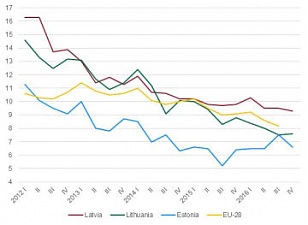Analytics, EU – Baltic States, Labour-market, Latvia, Statistics
International Internet Magazine. Baltic States news & analytics
Friday, 26.04.2024, 04:56
Unemployment rate in Latvia was still reducing in 2016
 Print version
Print version |
|---|
Compared to the 3rd quarter, in the 4th quarter of 2016 the unemployment rate dropped by 0.2 percentage points and constituted 9.3%. In the 4th quarter, 90.8 thousand persons aged 15–74 were unemployed – 3.6 thousand or 3.8% less than in the 3rd quarter.
Even though Latvian unemployment rate keeps reducing, it still slightly exceeds the European Union (EU) average. In the 3rd quarter of 2016, the Latvian unemployment rate (9.5%) exceeded the EU average (8.2%) by 1.3 ppt. In the 4th quarter, the Latvian unemployment rate still was the highest among the Baltic states, compared to 6.6% in Estonia and 7.6% in Lithuania.
Unemployment rate in the Baltic states and average in the European Union, %

Data source: Eurostat database, the data on the 4th quarter of 2016 – the Labour Force Surveys of Latvia, Lithuania and Estonia
Long-term unemployed persons
In 2016, the share of long-term unemployed persons, i.e., those who have been without work for 12 months or longer, in the total number of unemployed persons fell by 4 percentage points – from 45.5% in 2015 to 41.5 % in 2016. Over the year, the number of long-term unemployed persons declined by 5 thousand, and in it accounted for 39.5 thousand.
In the 4th quarter of 2016, the share of long-term unemployed in the total number of unemployed persons constituted 38.2%. Compared to the 3rd quarter of 2016, their number has decreased by 3.4 ppt. In the 4th quarter there were 34.5 thousand long-term unemployed persons and in the 3rd quarter – 39.3 thousand.
Youth unemployment
In 2016, youth unemployment rate constituted 17.3%; it was 1ppt higher than a year ago (16.3% in 2015). Out of the total number of unemployed persons, 13.0 thousand or 13.6% were young people aged 15–24. Over the year, the number of young unemployed persons dropped by 0.5 thousand, and their share in the total number of unemployed persons fell by 0.2 ppt.
In the 4th quarter of 2016, the youth unemployment rate constituted 15.8%; it was 3.5 ppt lower than in the 3rd quarter. The number of young unemployed persons declined by 3.7 thousand and comprised 10.9 thousand or 12.0% of the total number of unemployed persons (14.6 thousand or 15.5% in the 3rd quarter).
Since 2013 the Latvian youth unemployment rate has been lower than the EU average. In 2015, the Latvian youth unemployment rate (16.3%) was 4 ppt lower than the EU average (20.3%). In the 4th quarter of 2016, the Latvian youth unemployment rate still was the highest among the Baltic states, compared to 13.4% in Estonia and 14.5% in Lithuania.
Youth unemployment rate in the Baltic states and average in the European Union, %

Data source: Eurostatdatabase, the data on the 4th quarter of 2016 – Labour Force Surveys of Latvia, Lithuania and Estonia
In the 4th quarter of 2016, 37.4% of all young people were active, i.e., employed or actively seeking a job (unemployed), whereas 62.6% of the young people were inactive (mainly studying and not seeking a job).
Inactive population
In 2016, 31.8% or 461.7 thousand persons aged 15–74 were inactive. i.e., were neither employed nor actively seeking a job. Compared to the year before, the inactive population has declined by 16.7 thousand or 3.5%. In the 4th quarter, 32.0% or 461.6 thousand persons aged 15–74 were inactive. Compared to the 3rd quarter, the inactive population has increased by 3.7 thousand or 0.8%.
In 2016, 20.2 thousand persons or 4.4% of inactive population were discouraged to find a job (22.8 thousand or 4.8% in 2015). In the 4th quarter, the number of such inactive population accounted for 23.5 thousand or 5.1% (19.3 thousand or 4.2 % in the 3rd quarter of 2015).
In 2016, the Labour Force Survey covered 15.8 thousand households, in which 29.8 thousand persons aged 15–74 were interviewed. In the 4th quarter of 2016, the Labour Force Survey covered 4 thousand households, in which 7.6 thousand persons aged 15–74 were interviewed.








 «The Baltic Course» Is Sold and Stays in Business!
«The Baltic Course» Is Sold and Stays in Business!

